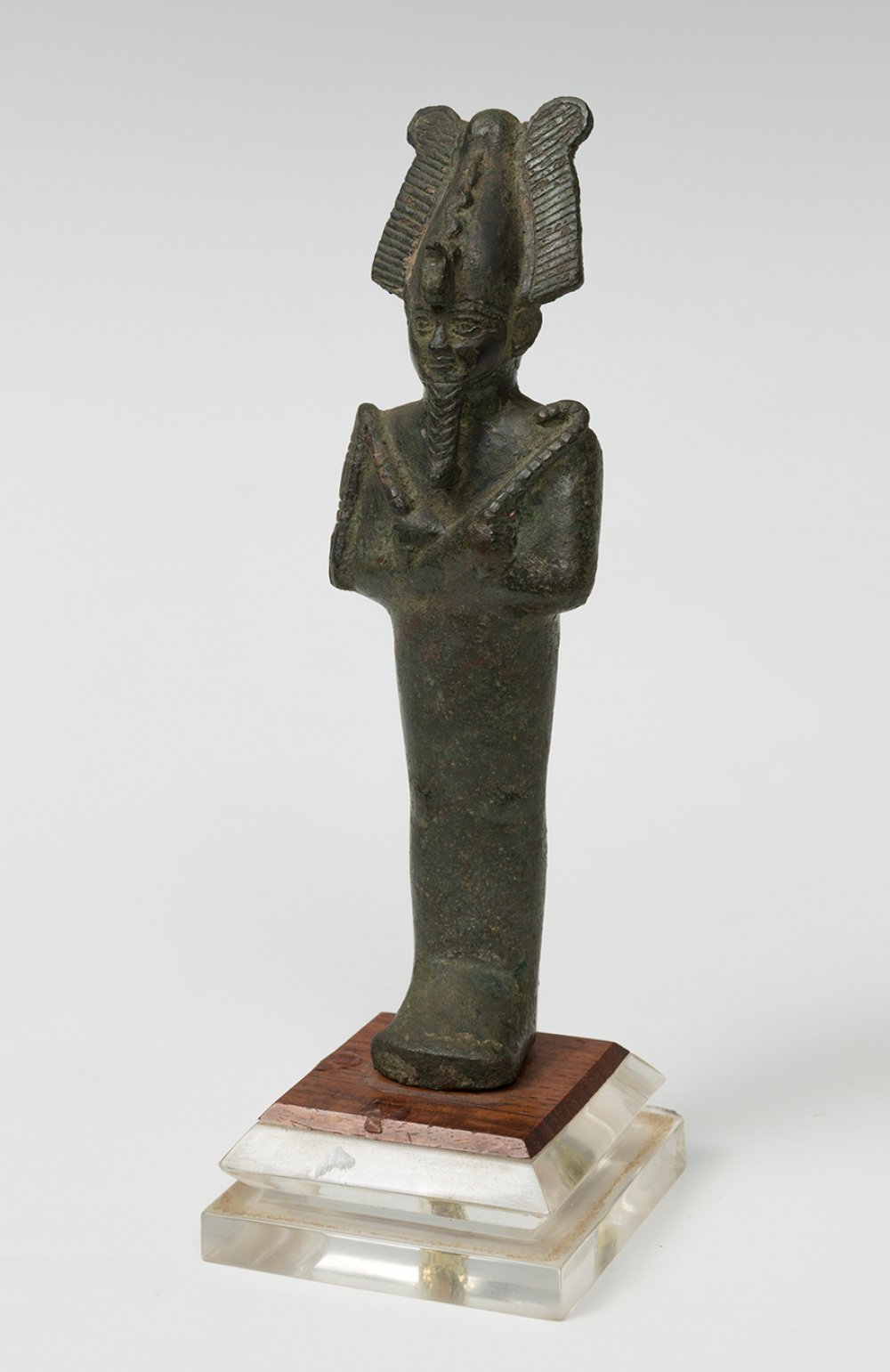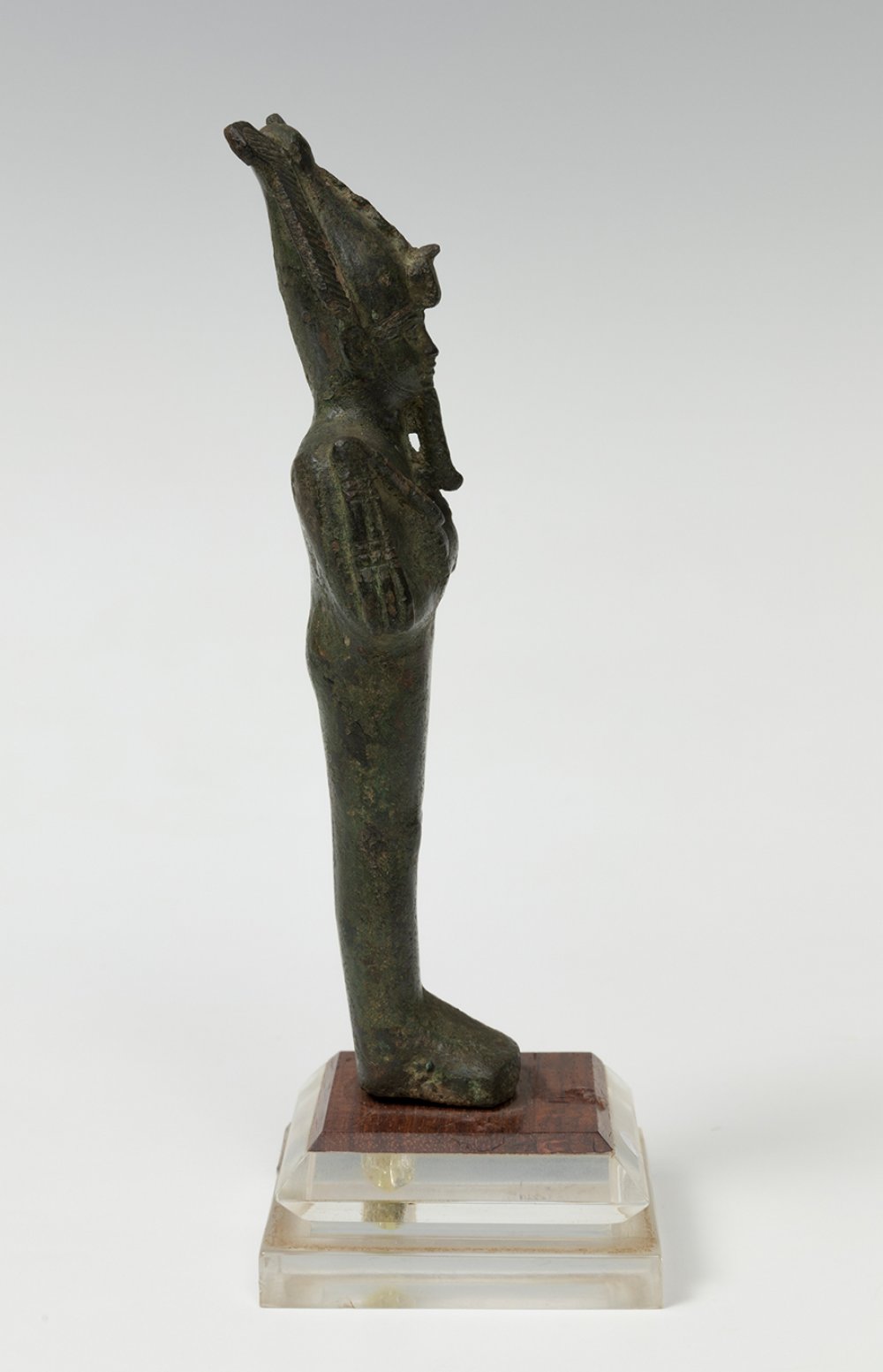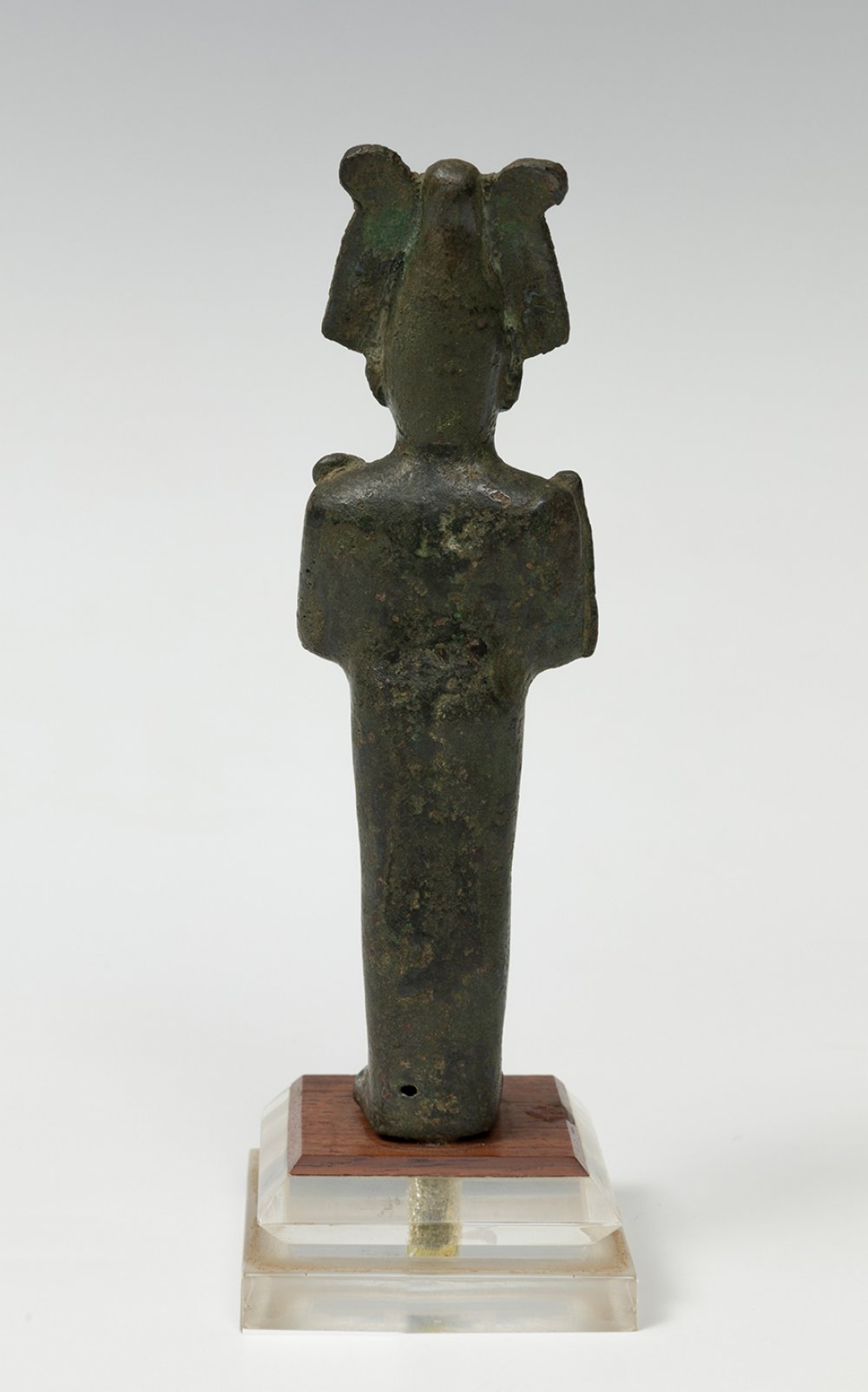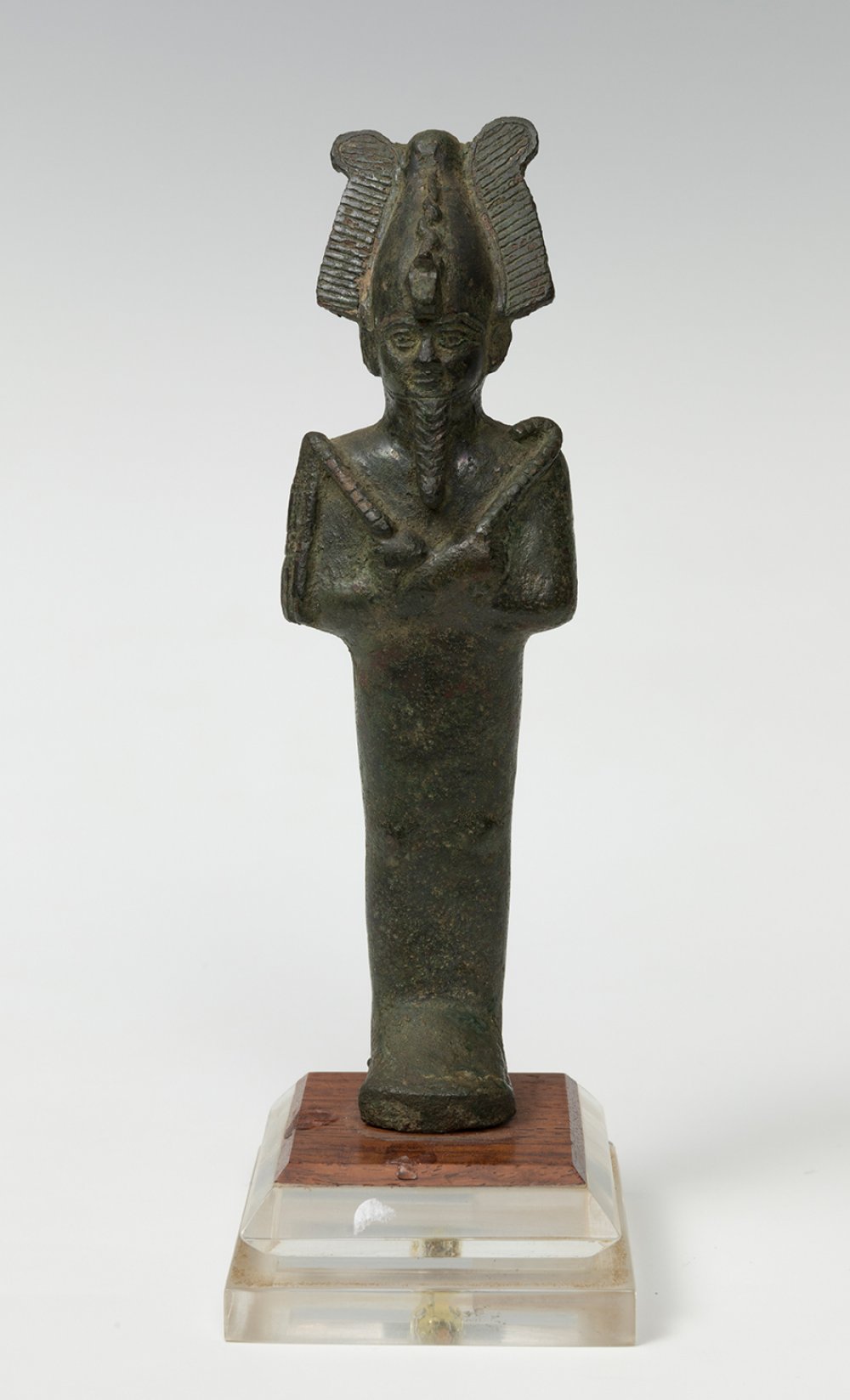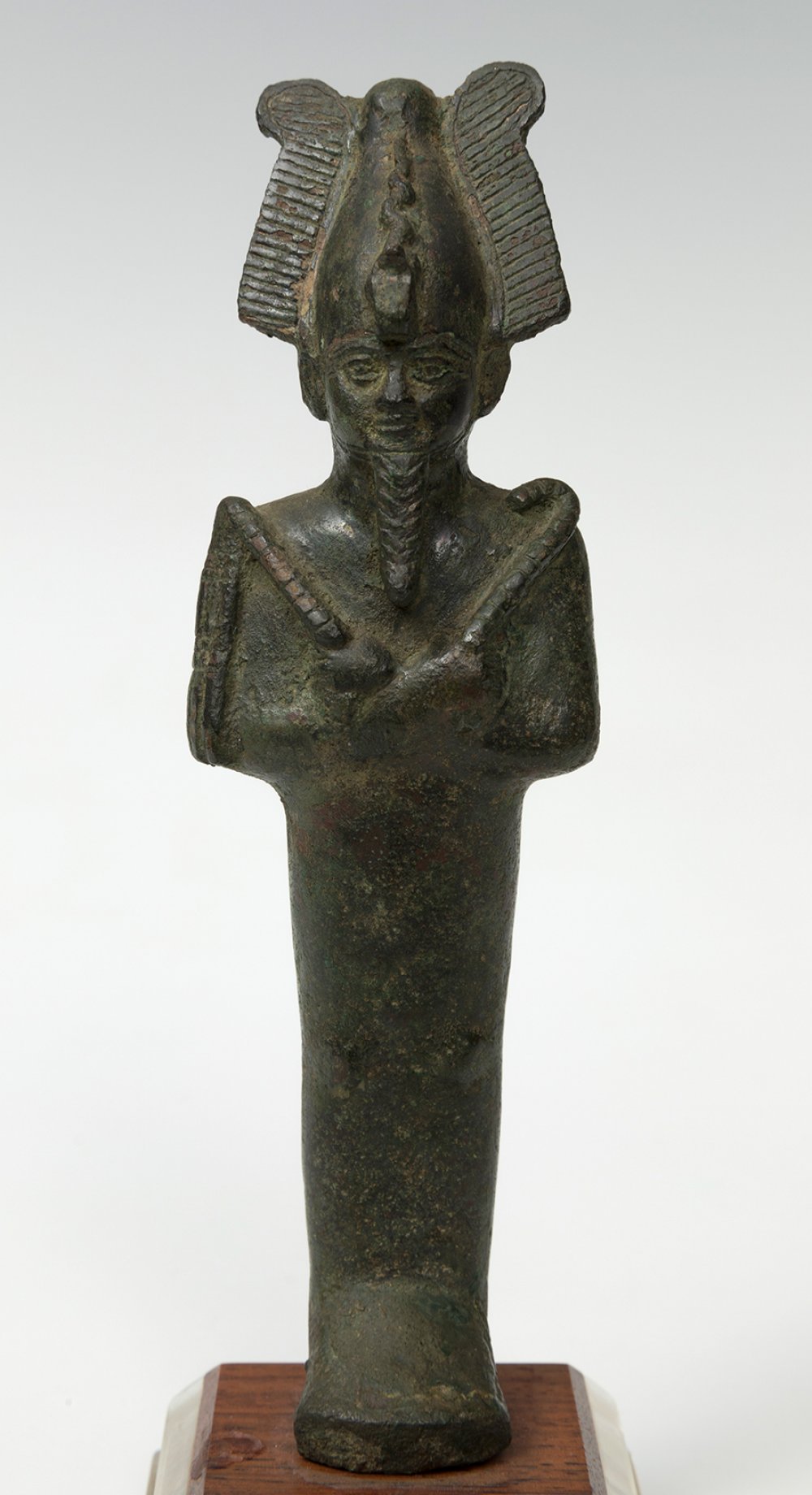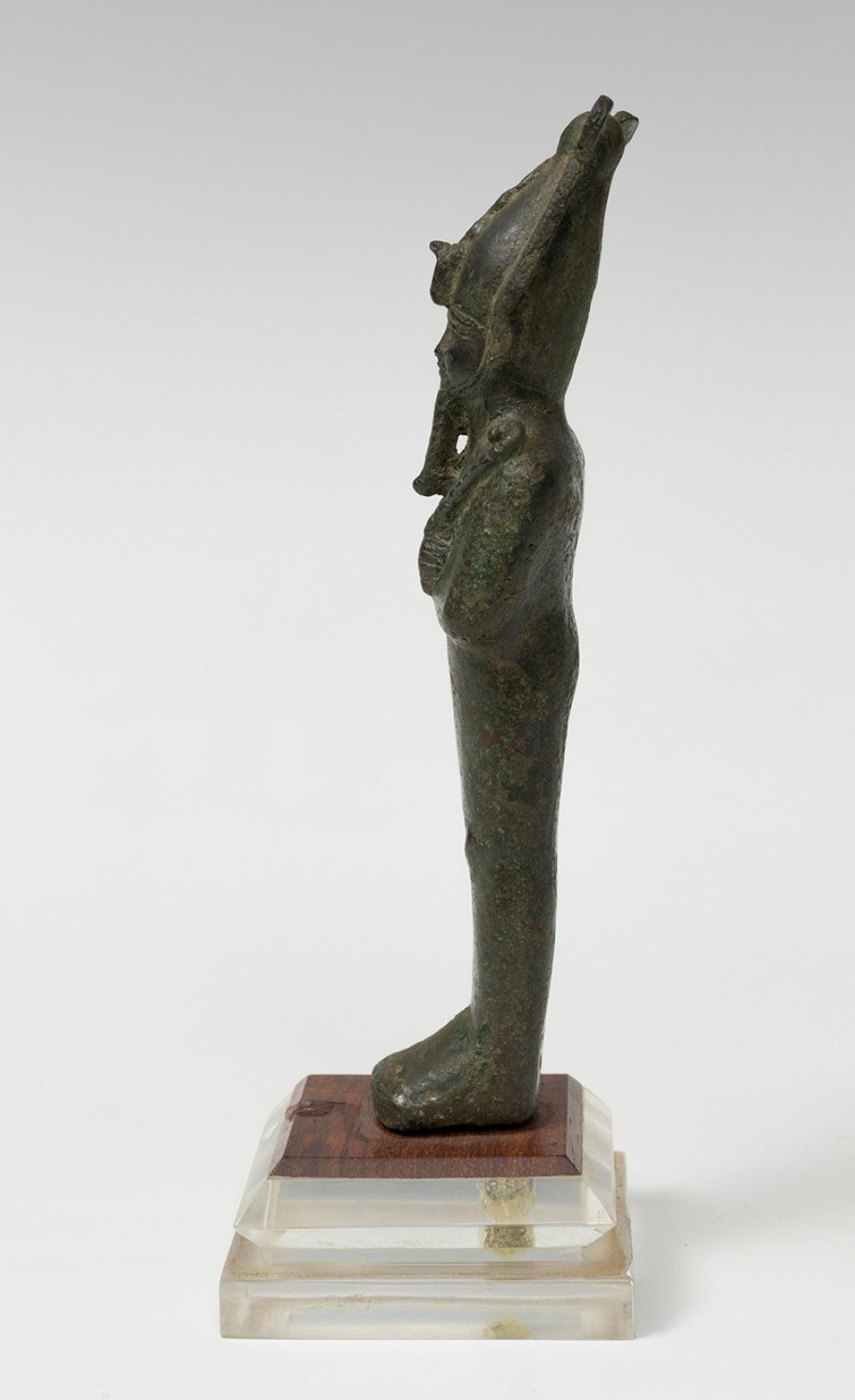59
Sculpture of Osiris; Egypt, Late Antiquity, 664-332 BC.Bronze.Size: 14 x 4 x 3 cm.Moniform amulet
Bronze.
Size: 14 x 4 x 3 cm.
Moniform amulet statuette of Osiris, represented with the attributes typical of the figure. An atef crown, with the solar disc and ostrich feathers, the whip (mayal or nenej) and the uas sceptre. These are the most characteristic iconographic attributes of this deity, representing the power and authority of Osiris as king of the gods and supreme authority over the earth and crops. Osiris is the Egyptian god of resurrection, associated with the fertility and regeneration of the Nile, protector of vegetation and agriculture. He also presides over the court of judgement of the dead, and is in fact closely associated with the afterlife. He is usually depicted mummified, with the attributes of royalty: Atef crown, hela staff and nejej whip or uas sceptre, as seen here. Osiris was considered the first-born son of Geb, divinity of the earth, and the goddess Nut, representation of the sky. He was therefore the brother and husband of Isis, with whom he had a posthumous son, Horus. We find him for the first time in the sources of the 5th Dynasty, although it is most likely that he was worshipped much earlier. In fact, we find the epithet Khenti-Amentiu ("leader of the Orientals", alluding to his role as king of the Beyond) already used in the 1st Dynasty, both in relation to divinity and as a pharaonic title. The most valuable information about Osiris is found in the Pyramid Texts of the late 5th Dynasty, the Shabaka Stone of the New Empire and, much later, in the texts of Greek writers such as Plutarch and Diodorus. Osiris was considered not only a merciful judge, but also the protector of the underworld, and thus the guarantor of the birth of vegetation and the flooding of the Nile. Also, in connection with his myth of rebirth after death, Osiris began to be associated with natural cycles, especially those related to agriculture.
In terms of his mythology, the cult of Osiris as the god of regeneration and rebirth is of particular interest because of his concept of immortality. Plutarch records a version of the myth in which Set, Osiris' brother, conspires with the queen of Ethiopia to assassinate him. Set tricked Osiris into putting himself inside a box, which he then closed, sealed with lead and threw into the Nile (this box is the origin of the Egyptian sarcophagus). Osiris' wife, Isis, found his corpse and used a spell to bring him back to life so that he could impregnate her. After this, the god died again and his wife hid his body in the desert. Months later, Isis would give birth to Horus, who would finally avenge his father.
Bronze.
Size: 14 x 4 x 3 cm.
Moniform amulet statuette of Osiris, represented with the attributes typical of the figure. An atef crown, with the solar disc and ostrich feathers, the whip (mayal or nenej) and the uas sceptre. These are the most characteristic iconographic attributes of this deity, representing the power and authority of Osiris as king of the gods and supreme authority over the earth and crops. Osiris is the Egyptian god of resurrection, associated with the fertility and regeneration of the Nile, protector of vegetation and agriculture. He also presides over the court of judgement of the dead, and is in fact closely associated with the afterlife. He is usually depicted mummified, with the attributes of royalty: Atef crown, hela staff and nejej whip or uas sceptre, as seen here. Osiris was considered the first-born son of Geb, divinity of the earth, and the goddess Nut, representation of the sky. He was therefore the brother and husband of Isis, with whom he had a posthumous son, Horus. We find him for the first time in the sources of the 5th Dynasty, although it is most likely that he was worshipped much earlier. In fact, we find the epithet Khenti-Amentiu ("leader of the Orientals", alluding to his role as king of the Beyond) already used in the 1st Dynasty, both in relation to divinity and as a pharaonic title. The most valuable information about Osiris is found in the Pyramid Texts of the late 5th Dynasty, the Shabaka Stone of the New Empire and, much later, in the texts of Greek writers such as Plutarch and Diodorus. Osiris was considered not only a merciful judge, but also the protector of the underworld, and thus the guarantor of the birth of vegetation and the flooding of the Nile. Also, in connection with his myth of rebirth after death, Osiris began to be associated with natural cycles, especially those related to agriculture.
In terms of his mythology, the cult of Osiris as the god of regeneration and rebirth is of particular interest because of his concept of immortality. Plutarch records a version of the myth in which Set, Osiris' brother, conspires with the queen of Ethiopia to assassinate him. Set tricked Osiris into putting himself inside a box, which he then closed, sealed with lead and threw into the Nile (this box is the origin of the Egyptian sarcophagus). Osiris' wife, Isis, found his corpse and used a spell to bring him back to life so that he could impregnate her. After this, the god died again and his wife hid his body in the desert. Months later, Isis would give birth to Horus, who would finally avenge his father.
29th September - Archaeology
Sale Date(s)
Venue Address
General delivery information available from the auctioneer
Setdart offers Worldwide shipping
PICK UP IN ROOM: You can come and pick up your lots in our offices (Barcelona, Madrid or Valencia). At the moment of the withdrawal, you will be able to accept the current conditions of the lot by means of a document that you will sign.
YOU CAN SEND ANOTHER PERSON TO PICK UP: This person must present a signed authorization that you can find in our web page by accessing from BUY AT SETDART- LOGISTICS-DOWNLOAD AUTHORIZATION DOCUMENT. You can also send an e-mail with the requested data in AUTHORIZATION DOCUMENT to admin@setdart.com
Important Information
25% buyer´s premium
21% buyer´s premium at www.setdart.com
Terms & Conditions
The maximum period to pay the lots is 7 working days. You can pay either via bank transfer or with credit card through our platform www.setdart.com (we only accept VISA or Mastercard).
BUYER´S PREMIUM: 22% Hammer price + 21% VAT from the buyer´s premium
If your piece has more than 100 years, our Ministry of Culture requires an export certificate in order for the piece to leave the country. Note that if the piece goes inside the EU, there is no cost for the export certificate. If the piece goes outside the EU, there is a cost for the export certificate. You can find more information in our Ministry of Culture website: https://www.culturaydeporte.gob.es/en/cultura/patrimonio/exportacionimportacion/exportacion/tasas.html
INQUIRIES: admin@setdart.com
Setdart guides you through the entire process, from the time of award to the day you receive your lot. Our logistics team will be happy to manage your transport, and will advise you on the best shipping method with professionals from the sector used to handling works of art and jewelry.
WE OFFER WORLDWIDE DOOR TO DOOR SHIPPING
PICK UP IN ROOM: You can come and pick up your lots in our offices. At the moment of the withdrawal, you will be able to accept the current conditions of the lot by means of a document that you will sign.
YOU CAN SEND ANOTHER PERSON TO PICK UP: This person must present a signed authorization that you can find in our web page by accessing from BUY AT SETDART-LOGISTICS-DOWNLOAD AUTHORIZATION DOCUMENT. You can also send an e-mail with the requested data in AUTHORIZATION DOCUMENT to admin@setdart.com
SETDART IS NOT RESPONSIBLE FOR THE STATE OF THE PARTS ONCE THEY LEAVE OUR FACILITIES. MRW SHIPMENTS: Once the payment is made, your lot will be packed for shipment, the logistics department will send you an e-mail notifying you of the day it leaves our warehouse, changes of address cannot be made after receiving this e-mail.
INSURANCE INCIDENTS: Coverage for the value of the auction up to 3000 ? per shipment, if the value of the auction is higher, Setdart will send you a quote including the additional insurance. The insurance company WILL NOT BE RESPONSIBLE FOR THE SHIPMENT THAT EXCEEDS THAT AMOUNT AND IS NOT FULLY INSURED. MRW INCIDENTS: Maximum notification 48 hours after receipt, after which the insurance company WILL NOT BE RESPONSIBLE AND NO CLAIMS WILL BE ACCEPTED.
E-MAIL LOGISTICS: logistica@setdart.com
PICK UP YOUR MESSAGES: You can send your own messaging, prior notice via e-mail that your shipment is ready, please note 3 or 4 days in advance. This type of shipment is packaged so Setdart will provide you with a quote.
EXPENSES FOR STORAGE: We inform you that if the purchased lot is not picked up within a month, you will be charged 30€ per week per lot. Setdart Online S.L., owner of the web site "setdart.com", "setdart.net" and "setdart.org", acts as a company of Spanish nationality inscribed in the Volume 36955, sheet 182, page B-293056 of the Mercantile Registry, with registered office at Calle Aragó













